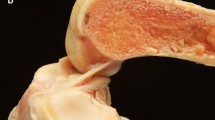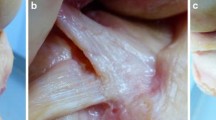Abstract
Knowledge of the anatomy of the anterior cruciate ligament (ACL), including its course and orientation in relation to the roof of the intercondylar fossa, is a prerequisite for successful intra-articular ACL reconstruction. To attain precision placement of the tibial attachment site and to avoid graft/roof conflict in the extended knee position, we assessed the anteroposterior tibial insertion of the ACL in the midsagittal plane of the extended knee. We measured the anterior-posterior (AP) limits and the center of the tibial attachment area of the ACL from the anterior tibial margin. The inclination angle of the intercondylar fossa roof was measured with respect to the shaft axis of the femur. The tibial attachment area of the ACL was determined in ten cadaveric knees. Using the cryoplaning technique, we determined the tibital attachment of the ACL in five knees. Using contrast magnetic resonance arthrography (MRA), we measured the tibial insertion of the ACL in 35 patients (23 male and 12 female) with intact ACLs. The total AP midsagittal diameter of the tibia averaged 51.0±5.8 mm in the cadaveric knees, 49 mm on cryosections, and 53.7 mm in men and 49.0 mm in women with MRA. The average anterior limit of the ACL, measured from the anterior tibial margin, was 14±4.2 mm in the cadaveric knees, 12.1 mm at cryosectional anatomy, and 15.2 mm in men and 13.4 mm in women with MRA. The center of the tibial attachment area was located at 21±2.6 mm in cadaveric knees, at 21.2 mm on cryosections, and at 23.7 mm in men and at 21.4 mm in women with MRA. The posterior limit of the tibial attachment area of the ACL was 29.0±4.1 mm in cadaveric knees, 30.6 mm on cryosections, 32.1 mm in male and 29.4 mm female patients with MRA. The roof inclination angle measured on average 39.8° on cryosections and 36.8° in men and 35.2° in women on MRA. Based on these morphometric data and to avoid notch/graft conflict in knee extension, we advocate placing the center of the tibial tunnel at 44% of the tibia diameter posterior and parallel to the individual intercondylar roof inclination angle.
Similar content being viewed by others
References
Ahmed AM, Hyder A, Burke DL, Chan KD, (1987) In-vitro ligament tension pattern in flexed knee in passive loading. J Orthop Res 5: 217–230
Amis AA (1989) Anterior cruciate ligament replacement. Knee stability and the effects of implants. J Bone Joint Surg [Br] 71: 819–824
Amis AA, Scammell BE (1993) Biomechanics of intra-articular and extra-articular reconstruction of the anterior cruciate ligament. J Bone Joint Surg [Br] 75: 812–817
Anderson AF, Lipscomb AB, Luidahl K et al. (1987) Analysis of the intercondylar notch by computed tomography. Am J Sports Med 15: 547–552
Arms SW, Pope MH, Johnson RJ, Fischer RA, Arvidsson I, Eriksson E (1984) The biomechanics of anterior cruciate ligament rehabilitation and reconstruction. Am J Sport Med 12: 8–18
Arnoczky SP, Warren RF (1994) Anatomy of the cruciate ligament. In: Feagin J (ed) The crucial ligaments, 2nd edn. Churchill Livingstone, New York, pp 269–286
Beynnon BD, Pope MH, Fleming BC et al (1989) An in-vivo study of the ACL strain biomechanics in the normal knee. Trans ORS 35: 324
Blankevoort L, Huiskes R (1991) ACL isometry is not the criterion for ACL reconstruction. Trans ORS 37: 203
Bradly J, Fitzpatriek D, Daniel D, Sherfeliff T, O'Connor J (1988) Orientation of the cruiciate ligament in the sagittal plane. A method of predicting its length-change with flexion. J Bone Joint Surg [Br] 70: 94–109
Butler DL, Noyes FR, Grood ES (1980) Ligamentous restraints to AP drawer in the human knee. J Bone Joint Surg [Am] 62: 259–270
Bylski-Austrow DI, Grood ES, Hefzy MS, Holden JP, Butler D (1990) Anterior cruciate ligament replacements: a mechanical study of femoral attachment location, flexion angle at tensioning, and initial tensioning. J Orthop Res 8: 522–531
Dijk R van (1983) The behaviour of the cruciate ligaments in the human knee. Radopi, Amsterdam, pp 1–163
Engebretsen L, Lew WD, Lewis JL, Hunter RE (1989) Knee mechanics after repair of the anterior cruciate ligament. A cadaver study of ligament augmentation. Acta Orthop Scand 60: 703–709
Feagin JA (1994) Loss of extension after ACL reconstruction. Case study 17. In: Feagin J (ed) The crucial ligaments, 2nd edn. Churchill Linvingstone, New York, pp 177–181
Feagin JA (1994) Inappropriate femoral tunnel placement. Case study 18. In: Feagin J (ed) The cruciate ligaments, 2nd edn. Churchill Livingstone, New York, pp 183–185
Fisher SE, Shelbourne KD (1993) Arthroscopic treatment of symptomatic extension block complicating anterior cruciate ligament reconstruction. Am J Sport Med 21: 558–564
Fleming BC, Beynnon BD, Nichols CE et al (1992) In vivo comparison between predictive isometry measurement and elongation in the reconstructed ACL. Trans ORS 38: 222
Fleming BC, Beynnon BD, Johnson RJ, McLeod WD, Pope MH (1992) Effect of tension and placement of prosthetic anterior cruciate ligament on the anteroposterior laxity of the knee. J Orthop Res 10: 177–186
Fleming BC, Beynnon BD, Johnson RJ, McLeod WD, Pope MH (1993) Isonetric versus tension measurements. A comparison for the reconstruction of the anterior cruciate ligament. Am J Sports Med 21: 82–88
Friederich NF, O'Brien WR (1992) Functional anatomy of the cruciate ligaments. In: Jakob RP, Stäubli HU (eds) The knee and the cruciate ligaments, Springer, Berlin Heidelberg New York, pp 78–91
Fukubayashi T, Torzilli PA, Sherman MF, Warren RF (1982) An in vitro biomechanical evaluation of AP motion of the knee. J Bone Joint Surg [Am] 64: 258–264
Furman W, Marshall JL, Girgis FG (1976) The anterior cruciate ligament. A functional analysis based on postmortem studies. J Bone Joint Surg [Am] 58: 179–185
Fuss FK (1989) Anatomy of the cruciate ligaments and their function in extension and flexion of the human knee joint. Am J Anat 84: 165–176
Fuss FK (1991) Optimal replacement of the cruciate ligaments from the functional-anatomical point of view. Acta Anat 140: 260–268
Gertel TH, Lew WD, Lewis JL, Stewart NJ, Hunter RE (1993) Effect of anterior cruciate ligament graft tensioning direction. magnitude, and flexion angle on knee biomechanics. Am J Sports Med 21: 572–581
Girgis FG, Marshall JL, Al Monajem ARS (1975) The cruciate ligaments of the knee joint. Anatomical, functional and experimental analysis. Clin Orthop 106: 216–231
Goble EM (1988) Fluoroarthroscopic allograft anterior cruciate reconstruction. Tech Orthop 2: 65–73
Good L, Odensten M, Gillquist J (1987) Precision in reconstruction of the anterior cruciate ligament. An new positioning device compared with hand drilling. Acta Orthop Scand 58: 658–661
Graf B (1987) Isometric placement of substitutes for the anterior cruciate ligament. In: Jackson DE, Drez D (eds) The anterior cruciate deficient knee. New concepts in ligament repair. Mosby, St Louis, pp 102–113
Hefzy MS, Grood ES (1986) Sensitivity of insertion locations on length patterns of anterior cruciate ligament fibers. J Biomech Eng 108: 73–82
Hefzy MS, Grood ES, Noyes FR (1989) Factors affecting the region of most isometric femoral attachments. Part II. The anterior cruciate ligament. Am J Sports Med 17: 208–216
Hoogland T, Hillen B (1984) Intra-articular reconstruction of the anterior cruciate ligement. An experimental study of length changes in different ligament reconstructions. Clin Orthop 185: 197–202
Howell SM (1994) Roof impingement of ACL grafts: diagnosis, cause prevention and late surgical correction. In: Feagin J (ed) The cruciate ligaments, 2nd edn. Churchill Livingstone, New York, pp 637–648
Howell SM, Major MD (1992) Arthroscopic roofplasty: a method for correcting an extension deficit caused by roof impingement of an anterior cruciate ligament graft. Arthroscopy 8: 375–379
Howell SM, Clark JA, Farley TE (1992) Serial magnetic resoncance study assessing the effects of impingment on the MR image of the patellar tendon graft. Arthroscopy 8: 350–358
Johnson RJ, Beynnon BD, Nichols CE, Renstrom PA (1992) Current concepts review. The treatment of injuries of the anterior cruciate ligament. J Bone Joint Surg [Am] 74: 140–151
Lewis JL, Lew WD, Hill JA et al (1989) Knece joint motion and ligament forces before and after ACL reconstruction. J Biomech Eng 111: 97–106
Lewis JL, Lew WD, Hill JA et al (1989) Knee joint motion and ligament forces before and after ACL reconstruction. J Biomech Eng 111: 97–106
Marans HJ, Hendrix MR, Paterson RS (1992) A new femoral drill guide for arthroscopically assisted anterior cruciate ligament replacement. Arthroscopy 8: 234–238
Markolf KL, Gorek, JF, Kabo M, Shapiro MS (1990) Direct measurement of resultant forces in the anterior cruciate ligament. An in vitro study performed with a new experimental technique. J Bone Joint Surg [Am] 72: 557–567
Marzo JM, Bowen MK, Warren RF, Wickiewicz TL, Altchek DW (1992) Intraarticular fibrous nodule as a cause of loss of extension following anterior cruciate ligament reconstruction. Arthroscopy 8: 10–18
Melby A, Noble JS, Askew MJ, Boom AA, Hurst FW (1991) The effects of graft tensioning on the laxity and kinematics of the anterior cruciate ligament reconstructed knee. Arthroscopy 7: 257–266
More RC, Markolf KL (1988) Measurement of stability of the knee and ligament force after implantation of synthetic anterior cruciate ligament. J Bone Joint Surg [Am] 70: 1020–1031
Muneta T, Yamamoto H, Takakuda K, Sakai H, Furua K (1993) Effects of postoperative immobilization on the reconstructed anterior cruciate ligament. An experimental study in rabbits. Am J Sports Med 21: 305–313
O'Brien WR, Friederich NR (1994) Isometric placement of cruciate ligament substitutes. In: Feagin J (ed) The cruciate ligaments. 2nd edn. Churchill Livingstone. New York, 595–604
O'Brien WR, Friederich NF (1994) Fiber recruitment of the cruciate ligaments. In: Feagin J (ed) The cruciate ligaments, 2nd edn. Churchill Livingstone. New York, pp 307–317
Odensten M, Gillquist J (1985) Functional anatomy of the anterior cruciate ligament and a rationale for reconstruction. J Bone Joint Surg [Am] 67: 257–262
Odensten M, Gillquist (1986) A modified technique for anterior cruciate ligament (ACL) surgery using a new drill guide for isometric positioning of the ACL. Clin Orthop 213: 154–158
Penner DA, Daniel DM, Wood O, Mishra D (1988) An in vitro study of anterior cruciate ligament graft placement and isometry. Am J Sports Med 16: 238–243
Rauschning W (1979) Popliteal cysts and their relation to the gastrocnemio-semimembranosus bursa. A clinical and anatomical study. Acta Orthop Scand (Suppl) 179: 1–43
Romano VM, Graf BK, Keene JS, Lange RH (1993) Anterior cruciate ligament reconstruction. The effect of tibial tunnel placement on range of motion. Am J Sports Med 21: 415–418
Sapega AA, Moyer RA, Schneck C, Komalahiranya N (1990) Testing for isometry during reconstruction of the anterior cruciate ligament. Anatomical and biomechanical considerations. J Bone Joint Surg [Am] 72: 259–267
Schutzer SF, Christen S, Jakob RP (1989) Further observations on the isometricity of the anterior cruciate ligament. An anatomical study using a 6-mm diameter replacement. Clin Orthop 42: 257–255
Sidels JA, Larson RV, Garbini JL, Downey DJ, Matsen FA (1988) Ligament length relationships in the moving knee. J Orthop Res 6: 593–610
Souryal TO, Freeman TR (1993) Intercondylar notch size and anterior cruciate ligament injuries in athletes. A prospective study. Am J Sports Med 21: 535–539
Stäubli HU (1994) Stress radiography of the knee joint. Measurements of knee motion limits in the frontal and sagittal planes. In: Feagin J (ed) The cruciate ligaments, 2nd edn. Churchill Livingstone, New York, pp 451–476
Author information
Authors and Affiliations
Rights and permissions
About this article
Cite this article
Stäubli, H.U., Rauschning, W. Tibial attachment area of the anterior cruciate ligament in the extended knee position. Knee Surg, Sports traumatol, Arthroscopy 2, 138–146 (1994). https://doi.org/10.1007/BF01467915
Issue Date:
DOI: https://doi.org/10.1007/BF01467915




